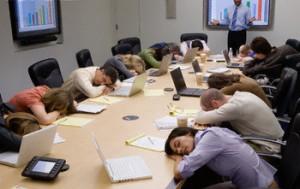 Picture an office meeting. What does it look like?
Picture an office meeting. What does it look like?
The setting is probably a conference room, dominated by a long wooden table. Leather chairs surround the table on all sides. Perhaps someone is in the middle of a presentation, gesturing toward a chart or pie graph projected onto a white screen.
If that’s your own mental image of a meeting, it’s certainly the image your employees have. And they’re the ones sitting in those chairs, struggling to focus because a) it’s morning and their coffee buzz hasn’t kicked in yet, b) it’s afternoon and they’re fighting a post-lunch food coma, or c) the meeting is just plain boring.You can’t affect coffee consumption or food comas, but you can steer whether you have ineffective meetings or meetings that are active and engaging, not passive snooze-fests.
Meetings can be interesting, engaging and purposeful, but to make it happen, you have to take the accepted meeting formula and tweak it. Here’s how.
- Get the blood flowing. Sitting is passive, and when you sit for long periods of time, your energy level naturally goes down. Get your meeting attendees up and moving around every so often, even if it’s just for five minutes. It could be something as simple as a break for a rock-paper-scissors tournament —anything to get your team standing up and doing something physical. Doing this combats disinterest and drowsiness better than any shot of caffeine.
- Set up the next segment. If you’re conducting a half-day or all-day meeting, end each segment with a question or a teaser for what is coming after the break, much like a TV show before a commercial break. If you can develop an air of anticipation about the next segment, you’ll increase engagement and interest levels returning from the break.
- Get to know each other. Pose general conversation starters such as, “What was your first job?” or “Do you have a nickname?” Go around the table and have everyone answer. It’s a simple way to break the ice, have casual conversation and lighten the mood. You can even give away small prizes (like gift cards) for the best answer, turning it into a friendly competition, which further engages your team members.
- Articulate the why. When you have games or activities to break up the monotony of a meeting, make sure those present understand the reasoning behind the games. It’s not arbitrary — it’s team building, and a way to make those long-but-necessary meetings more enjoyable and effective.
Pete Honsberger is the director of client services at CultureShoc. If you need assistance on how to transform ineffective meetings into productive ones, contact him at pete@cultureshoc.com.
